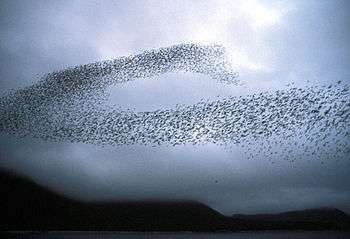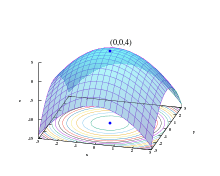Bees algorithm
In computer science and operations research, the bees algorithm is a population-based search algorithm which was developed in 2005.[1] It mimics the food foraging behaviour of honey bee colonies. In its basic version the algorithm performs a kind of neighbourhood search combined with global search, and can be used for both combinatorial optimization and continuous optimization. The only condition for the application of the bees algorithm is that some measure of topological distance between the solutions is defined. The effectiveness and specific abilities of the bees algorithm have been proven in a number of studies.[2][3][4][5]
Metaphor
A colony of honey bees can extend itself over long distances (over 14 km)[6] and in multiple directions simultaneously to harvest nectar or pollen from multiple food sources (flower patches). A small fraction of the colony constantly searches the environment looking for new flower patches. These scout bees move randomly in the area surrounding the hive, evaluating the profitability (net energy yield) of the food sources encountered.[6] When they return to the hive, the scouts deposit the food harvested. Those individuals that found a highly profitable food source go to an area in the hive called the “dance floor”, and perform a ritual known as the waggle dance.[7] Through the waggle dance a scout bee communicates the location of its discovery to idle onlookers, which join in the exploitation of the flower patch. Since the length of the dance is proportional to the scout’s rating of the food source, more foragers get recruited to harvest the best rated flower patches. After dancing, the scout returns to the food source it discovered to collect more food. As long as they are evaluated as profitable, rich food sources will be advertised by the scouts when they return to the hive. Recruited foragers may waggle dance as well, increasing the recruitment for highly rewarding flower patches. Thanks to this autocatalytic process, the bee colony is able to quickly switch the focus of the foraging effort on the most profitable flower patches.[6]
Algorithm
The bees algorithm[2][8] mimics the foraging strategy of honey bees to look for the best solution to an optimisation problem. Each candidate solution is thought of as a food source (flower), and a population (colony) of n agents (bees) is used to search the solution space. Each time an artificial bee visits a flower (lands on a solution), it evaluates its profitability (fitness).
The bees algorithm consists of an initialisation procedure and a main search cycle which is iterated for a given number T of times, or until a solution of acceptable fitness is found. Each search cycle is composed of five procedures: recruitment, local search, neighbourhood shrinking, site abandonment, and global search.
Pseudocode for the standard bees algorithm[2] 1 for i=1,…,ns i scout[i]=Initialise_scout() ii flower_patch[i]=Initialise_flower_patch(scout[i]) 2 do until stopping_condition=TRUE i Recruitment() ii for i =1,...,nb 1 flower_patch[i]=Local_search(flower_patch[i]) 2 flower_patch[i]=Site_abandonment(flower_patch[i]) 3 flower_patch[i]=Neighbourhood_shrinking(flower_patch[i]) iii for i = nb,...,ns 1 flower_patch[i]=Global_search(flower_patch[i])}
In the initialisation routine ns scout bees are randomly placed in the search space, and evaluate the fitness of the solutions where they land. For each solution, a neighbourhood (called flower patch) is delimited.
In the recruitment procedure, the scouts that visited the nb≤ns fittest solutions (best sites) perform the waggle dance. That is, they recruit foragers to search further the neighbourhoods of the most promising solutions. The scouts that located the very best ne≤nb solutions (elite sites) recruit nre foragers each, whilst the remaining nb-ne scouts recruit nrb≤nre foragers each. Thus, the number of foragers recruited depends on the profitability of the food source.
In the local search procedure, the recruited foragers are randomly scattered within the flower patches enclosing the solutions visited by the scouts (local exploitation). If any of the foragers in a flower patch lands on a solution of higher fitness than the solution visited by the scout, that forager becomes the new scout. If no forager finds a solution of higher fitness, the size of the flower patch is shrunk (neighbourhood shrinking procedure). Usually, flower patches are initially defined over a large area, and their size is gradually shrunk by the neighbourhood shrinking procedure. As a result, the scope of the local exploration is progressively focused on the area immediately close to the local fitness best. If no improvement in fitness is recorded in a given flower patch for a pre-set number of search cycles, the local maximum of fitness is considered found, the patch is abandoned (site abandonment), and a new scout is randomly generated.
As in biological bee colonies,[6] a small number of scouts keeps exploring the solution space looking for new regions of high fitness (global search). The global search procedure re-initialises the last ns-nb flower patches with randomly generated solutions.
At the end of one search cycle, the scout population is again composed of ns scouts: nr scouts produced by the local search procedure (some of which may have been re-initialised by the site abandonment procedure), and ns-nb scouts generated by the global search procedure. The total artificial bee colony size is n=ne•nre+(nb-ne)•nrb+ns (elite sites foragers + remaining best sites foragers + scouts) bees.
Variants
In addition to the basic bees algorithm,[8] there are a number of improved or hybrid versions of the BA, each of which focuses on some shortcomings of the basic BA. These variants include (but are not limited to) fuzzy or enhanced BA (EBA),[9] grouped BA (GBA),[5] hybrid modified BA (MBA)[10] and so on.
See also
- Ant colony optimization algorithms
- Artificial bee colony algorithm
- Evolutionary computation
- Lévy flight foraging hypothesis
- Manufacturing Engineering Centre
- Mathematical optimization
- Metaheuristic
- Particle swarm optimization
- Swarm intelligence
References
- ↑ Pham DT, Ghanbarzadeh A, Koc E, Otri S, Rahim S and Zaidi M. The Bees Algorithm. Technical Note, Manufacturing Engineering Centre, Cardiff University, UK, 2005.
- 1 2 3 Pham, D.T., Castellani, M. (2009), The Bees Algorithm – Modelling Foraging Behaviour to Solve Continuous Optimisation Problems. Proc. ImechE, Part C, 223(12), 2919-2938.
- ↑ Pham, D.T. and Castellani, M. (2013), Benchmarking and Comparison of Nature-Inspired Population-Based Continuous Optimisation Algorithms, Soft Computing, 1-33.
- ↑ Pham, D.T. and Castellani, M. (2015), A comparative study of the bees algorithm as a tool for function optimisation, Cogent Engineering 2(1), 1091540.
- 1 2 Nasrinpour, H. R., Massah Bavani, A., Teshnehlab, M., (2016), Grouped Bees Algorithm: A Grouped Version of the Bees Algorithm, Preprints 2016, 2016110070 (doi: 10.20944/preprints201611.0070.v1)
- 1 2 3 4 Tereshko V., Loengarov A., (2005) Collective Decision-Making in Honey Bee Foraging Dynamics. Journal of Computing and Information Systems, 9(3), 1-7.
- ↑ Von Frisch, K. (1967) The Dance Language and Orientation of Bees. Harvard University Press, Cambridge, MA.
- 1 2 Pham D.T., Ghanbarzadeh A., Koc E., Otri S., Rahim S., Zaidi M., The Bees Algorithm, A Novel Tool for Complex Optimisation Problems, Proc 2nd Int Virtual Conf on Intelligent Production Machines and Systems (IPROMS 2006), Oxford: Elsevier, pp. 454-459, 2006.
- ↑ Pham D. T., Haj Darwish A., (2008), A. Fuzzy Selection of Local Search Sites in the Bees Algorithm. Proceedings of Innovative Production Machines and Systems (IPROMS 2008)
- ↑ Pham Q. T., Pham D. T., Castellani M., A modified Bees Algorithm and a statistics-based method for tuning its parameters. Proceedings of the Institution of Mechanical Engineers (ImechE), Part I: Journal of Systems and Control Eng., 2011 (doi:10.1177/0959651811422759)
External links
- The bees algorithm website
- Boffins put dancing bees to work – BBC News
- An optimisation algorithm based on honey bees' food foraging behaviour

